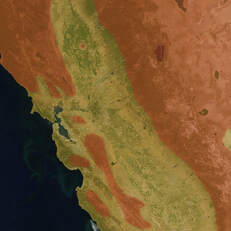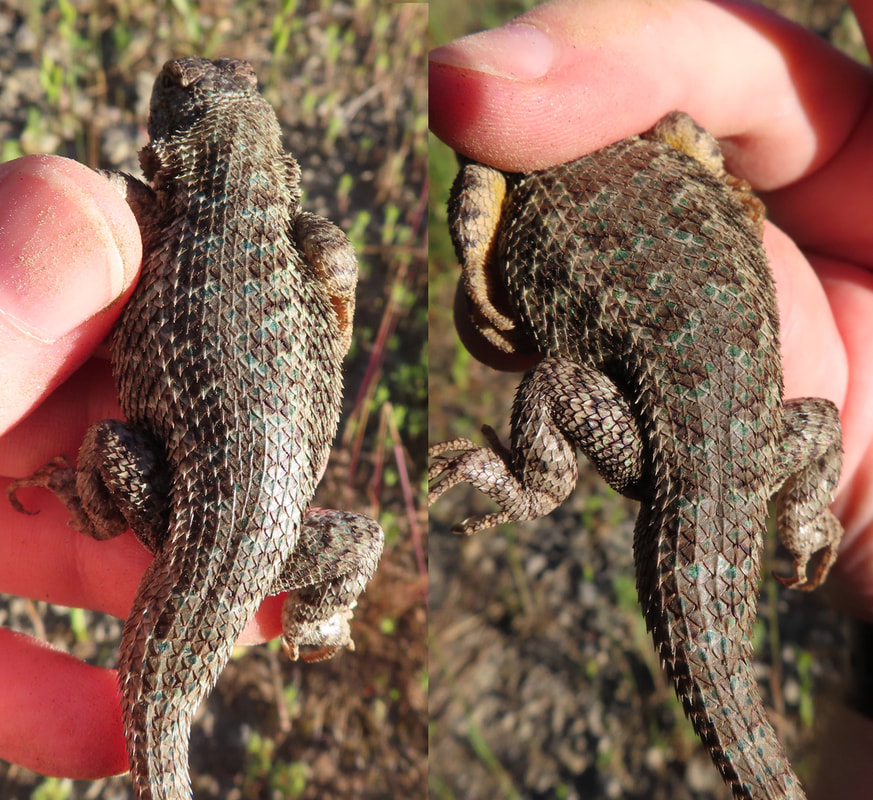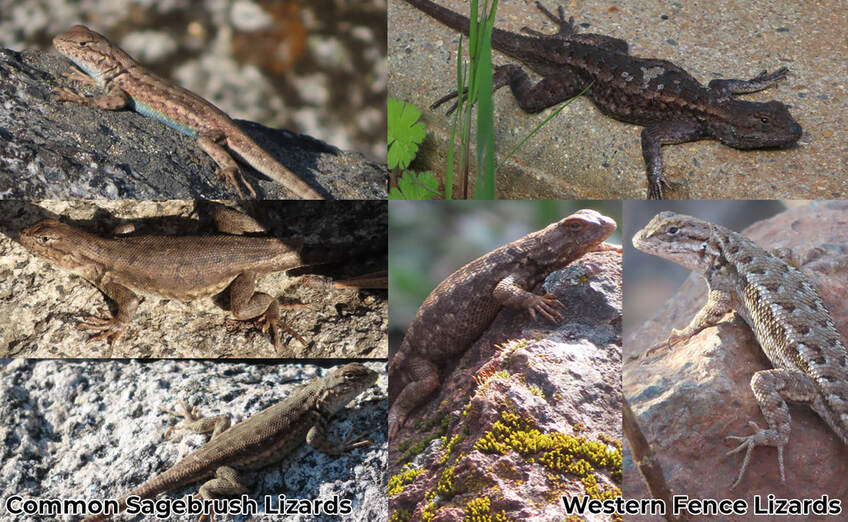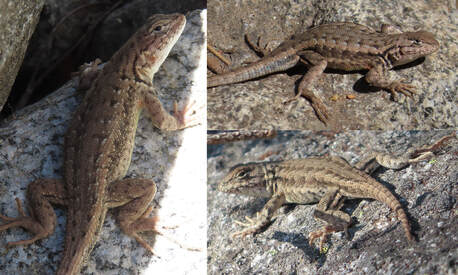Distinguishing Between Western Fence Lizards and
Common Sagebrush Lizards
Lizards of the Sceloporus genus, commonly known as Spiny Lizards, Fence Lizards, or Bluebellies, are perhaps the most commonly-encountered reptiles of the American West. In Northern California, there are only two species of Sceloporus, the Western Fence Lizard (Sceloporus occidentalis) and the Common Sagebrush Lizard (Sceloporus graciosus), but these two species look very similar and can be difficult to distinguish. The below information can be used to help identify which of the two lizards you've encountered. This information is written specifically based on Northern Californian populations of both species, but should also apply to all populations along the Pacific Coast and in the Sierra and Cascade mountain ranges.
|
Range
Range is by far the easiest way to distinguish between a Western Fence Lizard and Common Sagebrush Lizard. While Western Fence Lizards are habitat generalists and occur over all of the state, except in barren deserts, Common Sagebrush Lizards only occur at higher elevations, usually 500ft / 150m and above. Generally speaking, Common Sagebrush Lizards occur within pine forests and are absent from the grasslands and deciduous forest habitats in lower elevations. There are some exceptions to this, such as along the northwest coast of California the Pacific Ocean keeps the climate cool and moist enough for Common Sagebrush Lizards to occur at lower elevations than elsewhere in the state. They are also present in the mostly-deciduous forests in the eastern slopes of the Coast Range around Clear Lake and Lake Berryessa, even though they are generally absent from similar habitats elsewhere. As nearly all of the urban and suburban environments in California are in lower elevations, Common Sagebrush Lizards don't occur in most areas where people live, while Western Fence Lizards are often abundant in these areas. |
Scales
The only definite way to distinguish between Western Fence Lizards and Common Sagebrush Lizards is by examining their scales. The scales on the back and sides of a Western Fence Lizard are larger and more strongly keeled (ridged on top with an extended point at the tip) than the corresponding scales on a Common Sagebrush Lizard. While this can be hard to judge if you're not viewing the species species side-by-side, a useful trick is to look at the scales on the lizard's back and base of the tail. On a Western Fence Lizard, the scales on the back and the base of the tail will be roughly the same size, the tail scales may be slightly larger but not considerably so. On a Common Sagebrush Lizard, the scales on the back will be noticeably smaller and less keeled than the scales on the base of the tail.
The only definite way to distinguish between Western Fence Lizards and Common Sagebrush Lizards is by examining their scales. The scales on the back and sides of a Western Fence Lizard are larger and more strongly keeled (ridged on top with an extended point at the tip) than the corresponding scales on a Common Sagebrush Lizard. While this can be hard to judge if you're not viewing the species species side-by-side, a useful trick is to look at the scales on the lizard's back and base of the tail. On a Western Fence Lizard, the scales on the back and the base of the tail will be roughly the same size, the tail scales may be slightly larger but not considerably so. On a Common Sagebrush Lizard, the scales on the back will be noticeably smaller and less keeled than the scales on the base of the tail.
|
The scales on the back of the lizard's thighs can also be used to distinguish between the species. The scales on the bottom of the thighs on a Western Fence Lizard are larger and overlap, while the same scales on a Common Sagebrush Lizard are smaller and usually don't overlap. However this characteristic can't be checked unless you have the lizard in-hand, so it is less useful for identifying lizards in the field.
|
Pattern
Both the Western Fence Lizard and Common Sagebrush Lizard have similar overall patterns, yet a great deal of individual variation within the species, making this a much less reliable method of identification. The below characteristics are general pattern rules for the species, but are not true for every individual lizard.
Both the Western Fence Lizard and Common Sagebrush Lizard have similar overall patterns, yet a great deal of individual variation within the species, making this a much less reliable method of identification. The below characteristics are general pattern rules for the species, but are not true for every individual lizard.
- Side colors - Female, and occasionally male, Common Sagebrush Lizards can develop an orange coloration around their mouths down the sides of their bodies. This usually becomes especially vibrant in the spring breeding season. Male Common Sagebrush Lizards often have an red-orange patch immediately behind their front legs. Western Fence Lizards of both sexes can develop an yellow-orange color behind both their front and back legs, males usually have more and brighter amounts of yellow-orange. Female Western Fence Lizards occasionally show some amount of orange on their heads in the spring breeding season, but never the amount that develops in Common Sagebrush Lizards.
- Forelimb bar - Many field guides report that Common Sagebrush Lizards have a black bar in front of their forelimb that is absent in Western Fence Lizards. While it is true that Common Sagebrush Lizards usually do have a black bar in front of their front leg, Western Fence Lizards in Northern California often have black markings in front of their forelimb as well. The black bar of a Common Sagebrush Lizard is usually more sharply defined along the edges - a distinct bar rather than more of a black smudge on Western Fence Lizards - but the presence of black in front of the forelimb alone is not enough to distinguish the species in this region.
- Back pattern - Both species have similar looking back patterns, but Common Sagebrush Lizards usually have a fairly well-defined dark stripe running along their side from above their front leg to their back leg. Western Fence Lizards can have a similar stripe, but theirs is usually less distinct along the edges and broken up by scattered lighter scales. The chevron/crossbar markings in between these side stripes tend to be larger in Western Fence Lizards, though this is especially variable between individuals.
Size
Western Fence Lizards are on average larger than Common Sagebrush Lizards. A lizard's size is generally measured in snout-to-vent length, or SVL, since lizards can drop and regrow their tails, making their snout-to-tail-tip length variable. When viewing a lizard from above, SVL roughly corresponds to the distance from the tip of the lizard's nose to the back edge of their hind legs. An adult Western Fence Lizard will have a SVL of around 2¾ - 3¾in / 70 - 94mm, while an adult Common Sagebrush Lizard will reach 2⅛ - 3½in / 55 - 89mm. Obviously there is a lot of overlap in sizes, and most lizards don't grow to the maximum recorded size, so this can only be used to distinguish the largest of lizards.
Western Fence Lizards are on average larger than Common Sagebrush Lizards. A lizard's size is generally measured in snout-to-vent length, or SVL, since lizards can drop and regrow their tails, making their snout-to-tail-tip length variable. When viewing a lizard from above, SVL roughly corresponds to the distance from the tip of the lizard's nose to the back edge of their hind legs. An adult Western Fence Lizard will have a SVL of around 2¾ - 3¾in / 70 - 94mm, while an adult Common Sagebrush Lizard will reach 2⅛ - 3½in / 55 - 89mm. Obviously there is a lot of overlap in sizes, and most lizards don't grow to the maximum recorded size, so this can only be used to distinguish the largest of lizards.
Beyond Northern California - Great Basin Populations
|
East of the Sierras and Cascades, Western Fence Lizards and Common Sagebrush Lizards tend to look much more distinct from each other. Populations of Western Fence Lizards in the Great Basin usually have much stronger horizontal barring, without the side striping running lengthwise down their body. Conversely, Common Sagebrush Lizards in the Great Basin usually have much stronger lengthwise striping, with much weaker horizontal or chevron markings, usually broken up by the striping.
|
Another Lookalike - Common Side-blotched Lizard
Common Side-blotched Lizards (Uta stansburiana) are a close relative of the Sceloporus genus and another California lizard that is sometimes confused with both Western Fence Lizards and Common Sagebrush Lizards, though they have several unique features that distinguish them. The Common Side-blotched Lizard gets its name from a black marking most individuals have on their sides behind their front leg. This spot can sometimes be faint or even completely absent, but it's the easiest method of identification on most lizards. Beyond their eponymous side-blotch, Common Side-blotched Lizards can be identified by their granular back scales, which are much smaller than either a Western Fence Lizard or Common Sagebrush Lizard's, and only slightly overlap, if they overlap at all. They also have loose fold of skin running down their side and additional folds of skin around their neck and shoulders, which are absent from either of the Sceloporus species. Common Side-blotched Lizards are also smaller than even Common Sagebrush Lizards, reaching a maximum SVL of around 2½in / 64mm. They don't occur across most of Northern California, being present only south of the Sacramento Delta in the Coast Range and western San Joaquin Valley, though they are abundant in Southern California and the Great Basin.
References and Additional Reading
Jones, Lawrence L. and Lovich, Robert E. Lizards of the American Southwest: A Photographic Field Guide, Rio Nuevo Publishers, 2009.
Stebbins, Robert C. and McGinnis, Samuel M. Peterson Field Guide to Western Reptiles and Amphibians, Fourth Edition, Houghton Mifflin Harcourt Publishing, 2018.
Nafis, Gary. A Guide to the Amphibians and Reptiles of California, http://www.californiaherps.com.
iNaturalist, https://www.inaturalist.org.
Stebbins, Robert C. and McGinnis, Samuel M. Peterson Field Guide to Western Reptiles and Amphibians, Fourth Edition, Houghton Mifflin Harcourt Publishing, 2018.
Nafis, Gary. A Guide to the Amphibians and Reptiles of California, http://www.californiaherps.com.
iNaturalist, https://www.inaturalist.org.

















